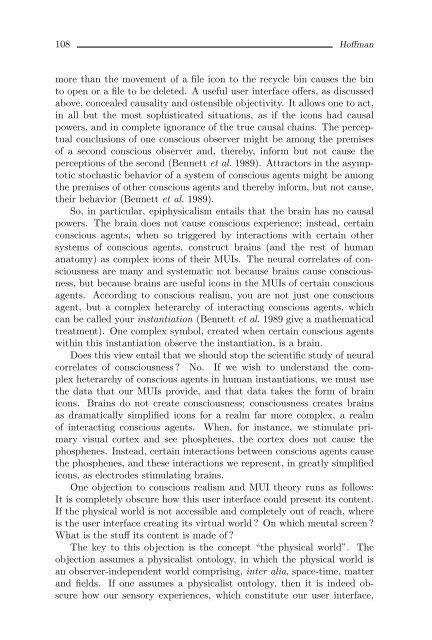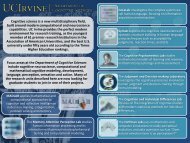Conscious Realism and the Mind-Body Problem - UCI Cognitive ...
Conscious Realism and the Mind-Body Problem - UCI Cognitive ...
Conscious Realism and the Mind-Body Problem - UCI Cognitive ...
Create successful ePaper yourself
Turn your PDF publications into a flip-book with our unique Google optimized e-Paper software.
108 Hoffmanmore than <strong>the</strong> movement of a file icon to <strong>the</strong> recycle bin causes <strong>the</strong> binto open or a file to be deleted. A useful user interface offers, as discussedabove, concealed causality <strong>and</strong> ostensible objectivity. It allows one to act,in all but <strong>the</strong> most sophisticated situations, as if <strong>the</strong> icons had causalpowers, <strong>and</strong> in complete ignorance of <strong>the</strong> true causal chains. The perceptualconclusions of one conscious observer might be among <strong>the</strong> premisesof a second conscious observer <strong>and</strong>, <strong>the</strong>reby, inform but not cause <strong>the</strong>perceptions of <strong>the</strong> second (Bennett et al. 1989). Attractors in <strong>the</strong> asymptoticstochastic behavior of a system of conscious agents might be among<strong>the</strong> premises of o<strong>the</strong>r conscious agents <strong>and</strong> <strong>the</strong>reby inform, but not cause,<strong>the</strong>ir behavior (Bennett et al. 1989).So, in particular, epiphysicalism entails that <strong>the</strong> brain has no causalpowers. The brain does not cause conscious experience; instead, certainconscious agents, when so triggered by interactions with certain o<strong>the</strong>rsystems of conscious agents, construct brains (<strong>and</strong> <strong>the</strong> rest of humananatomy) as complex icons of <strong>the</strong>ir MUIs. The neural correlates of consciousnessare many <strong>and</strong> systematic not because brains cause consciousness,but because brains are useful icons in <strong>the</strong> MUIs of certain consciousagents. According to conscious realism, you are not just one consciousagent, but a complex heterarchy of interacting conscious agents, whichcan be called your instantiation (Bennett et al. 1989 give a ma<strong>the</strong>maticaltreatment). One complex symbol, created when certain conscious agentswithin this instantiation observe <strong>the</strong> instantiation, is a brain.Does this view entail that we should stop <strong>the</strong> scientific study of neuralcorrelates of consciousness ? No. If we wish to underst<strong>and</strong> <strong>the</strong> complexheterarchy of conscious agents in human instantiations, we must use<strong>the</strong> data that our MUIs provide, <strong>and</strong> that data takes <strong>the</strong> form of brainicons. Brains do not create consciousness; consciousness creates brainsas dramatically simplified icons for a realm far more complex, a realmof interacting conscious agents. When, for instance, we stimulate primaryvisual cortex <strong>and</strong> see phosphenes, <strong>the</strong> cortex does not cause <strong>the</strong>phosphenes. Instead, certain interactions between conscious agents cause<strong>the</strong> phosphenes, <strong>and</strong> <strong>the</strong>se interactions we represent, in greatly simplifiedicons, as electrodes stimulating brains.One objection to conscious realism <strong>and</strong> MUI <strong>the</strong>ory runs as follows:It is completely obscure how this user interface could present its content.If <strong>the</strong> physical world is not accessible <strong>and</strong> completely out of reach, whereis <strong>the</strong> user interface creating its virtual world ? On which mental screen ?What is <strong>the</strong> stuff its content is made of ?The key to this objection is <strong>the</strong> concept “<strong>the</strong> physical world”. Theobjection assumes a physicalist ontology, in which <strong>the</strong> physical world isan observer-independent world comprising, inter alia, space-time, matter<strong>and</strong> fields. If one assumes a physicalist ontology, <strong>the</strong>n it is indeed obscurehow our sensory experiences, which constitute our user interface,







